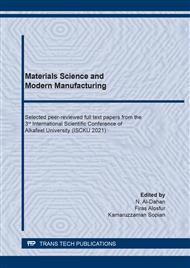[1]
P. Lichte, H. C. Pape, T. Pufe, P. Kobbe, & H. Fischer, Scaffolds for bone healing: concepts, materials and evidence. Injury, 42(6) (2011) 569-573.
DOI: 10.1016/j.injury.2011.03.033
Google Scholar
[2]
J. M. Anderson, A. Rodriguez & D. T. Chang, Foreign body reaction to biomaterials, In Seminars in immunology (Vol. 20, No. 2, (2008) pp.86-100, Academic Press.
DOI: 10.1016/j.smim.2007.11.004
Google Scholar
[3]
R. Narayan, ASM Hand book, Volume 23, Materials for Medical Devices. Materials Park: ASM International. (2012).
Google Scholar
[4]
B.V. Krishna, S. Bose, A. Bandyopadhyay, Low stiffness porous Ti structures for load-bearing implants, Acta Biomater. 3 (2007) 997-1006.
DOI: 10.1016/j.actbio.2007.03.008
Google Scholar
[5]
Z. Esen, B. Dikici, O. Duygulu, A.F. Dericioglu, Titanium–magnesium based composites: Mechanical properties and in-vitro corrosion response in Ringer's solution, Mater. Sci. Eng. A 573 (2013) 119-126.
DOI: 10.1016/j.msea.2013.02.040
Google Scholar
[6]
M.P. Staiger, A.M. Pietak, J. Huadmai, G. Dias, Magnesium and its alloys as orthopedic biomaterials: a review, Biomaterials 27 (2006) 1728-1734.
DOI: 10.1016/j.biomaterials.2005.10.003
Google Scholar
[7]
N.T. Kirkland, Magnesium biomaterials: past, present and future, Corrosion Engineering, Sci. Tech. 47 (2012) 322-328.
DOI: 10.1179/1743278212y.0000000034
Google Scholar
[8]
O. Duygulu, A.A. Kaya, G. Oktay, F.C. Sahin, Diffusion bonding of magnesium, zirconium and titanium as implant material, Mater. Sci. Forum 546–549 (2007) 417–420.
DOI: 10.4028/www.scientific.net/msf.546-549.417
Google Scholar
[9]
M. Qian, F.H. Froes, Titanium Powder Metallurgy: Science, Technology and Applications, Elsevier Science (2015) ISBN: 9780128009109.
Google Scholar
[10]
Haydar Al-Ethari, Sundus Abbas, Ekhlas Khalid Zamel, optimization of Manufacturing Titanium-Magnesium Alloy for Biomaterial Applications Using Grey Relational Analyses, 1st International Conference on Engineering Sciences: INTCSET 2020, will be published in the Journal of Material Sciences and Engineering: IOP Conference Series.
DOI: 10.1088/1757-899x/1094/1/012148
Google Scholar
[11]
H. Al-Ethari, A.H. Haleem, and N.M. Gased, IOP Publishing.May, An Investigation on Chemical Machining of NiTi SMA Prepared by Powder Metallurgy. In IOP Conference Series: Materials Science and Engineering (Vol. 518, No. 3, 2019, p.032032).].
DOI: 10.1088/1757-899x/518/3/032032
Google Scholar
[12]
A. H. Jaafar, & H. Al-Ethari, Numerical and experimental investigations of cutting force for NAB-CBN composite. The Iraqi journal for mechanical and materials engineering, 18(4), (2018) 589-603.
DOI: 10.32852/iqjfmme.v18i4.231
Google Scholar
[13]
Jaafar, A. H., & Al-Ethari, H. (2018). NUM ERICAL AND EXPERIMENTAL INVESTIGATIONS OF CUTTING FORCE FOR NAB-CBN COMPOSITE. THE IRAQI JOURNAL FOR MECHANICAL AND MATERIALS ENGINEERING, 18(4), 589-603].
DOI: 10.32852/iqjfmme.v18i4.231
Google Scholar
[14]
Sarah Muhi Jawad, Effect of (Cu & Cr) Additives on Corrosion and Dry Sliding Wear of NiTi Shape Memory Alloy, MSC thesis, Submitted to the Council of the College of Materials engineering / University of Babylon], (2015).
Google Scholar
[15]
I. Mutlu, and E.Oktay, Characterization of 17-4 PH stainless steel foam for biomedical applications in simulated body fluid and artificial saliva environments, Materials Science and Engineering: C, Vol. 33, No. 3, (2013) pp.1125-1131.
DOI: 10.1016/j.msec.2012.12.004
Google Scholar
[16]
G. K. Meenashisundaram, N.Wang, S., Lu, S. Maskomani, S. K. Anantharajan, S. T. Dheen, & J. Wei, Fabrication of Ti+ Mg composites by three-dimensional printing of porous Ti and subsequent pressureless infiltration of biodegradable Mg. Materials Science and Engineering: C, 108, (2020), 110478.
DOI: 10.1016/j.msec.2019.110478
Google Scholar
[17]
D.Kuroda, H. Kawasaki, S. Hiromoto, & T. HANAWA, (2005) Annual Book of ASTM Standards, Section 13, Medical Devices and Services Annual Book of ASTM Standards, Section 13, Medical Devices and Services, 2000, Materials transactions, 46(7), 1532-1539.
DOI: 10.1097/00149078-198806010-00014
Google Scholar
[18]
P. J. Leonard-Mayer, A surface resistivity method for measuring hydrologic characteristics of jointed formations (Vol. 8901), US Department of the Interior, Bureau of Mines (1984).
Google Scholar
[19]
Y. Okazaki, & E. Gotoh, Comparison of metal release from various metallic biomaterials in vitro. Biomaterials, 26(1), (2005) 11-21.
DOI: 10.1016/j.biomaterials.2004.02.005
Google Scholar
[20]
S. Ouyang, Y.Liu, Q., Huang, Z., Gan, & H. Tang, Effect of composition on in vitro degradability of Ti–Mg metal-metal composites. Materials Science and Engineering: C, 107, 110327, (2020).
DOI: 10.1016/j.msec.2019.110327
Google Scholar
[21]
Z. Esen, B. Dikici, O. Duygulu, and A.F. Dericioglu, Titanium–magnesium based composites: mechanical properties and in-vitro corrosion response in Ringer's solution. Materials Science and Engineering: A, 573, (2013) pp.119-126.
DOI: 10.1016/j.msea.2013.02.040
Google Scholar
[22]
D. F. Williams, Biocompatibility of Clinical Implant Mtls. CRC-Press, (1981).
Google Scholar


